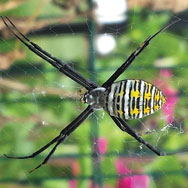Garden helpers and a beautiful part of nature Yellow garden spiders

By Patty Basic
OSU Extension master gardener volunteer
If I had spotted this spider in my garden a few years ago, my first reaction would be to scream, then stomp! Since becoming an OSU Extension master gardener volunteer, I have learned the benefit of good bugs in the garden. I’m much more observant. I found my beautiful spider and named her Charlotte. Charlotte has remained for several weeks in her web attached to a round fence bin where I grow my potatoes.
Charlotte is from the genus Argiope and species trifasciata, commonly known as the banded garden spider, a common orb web spider representing 9.5 percent of Ohio spiders. Orb means it spins the classic web in a wheel shape with many spokes oriented vertically. The web spirals out from the center and can be 2 feet across. During construction, the spider lays out very thin lines of non-sticky silk to keep tension, then makes the concentric circles, or radii. After sticky lines of silk are placed, non-sticky silk is cut away. In the center there is a stabilizing silk in the form of a zigzag called a stabilimentum. The female builds the large web, and a male will build a smaller web on the outer part of her web. The male’s web is a thick zigzag of white silk.
These spiders prefer sunny places with little or no wind. Each night, they can eat the web they made and build a new one, but not during molting or egg-laying season. They consume and recycle the silk, composed almost entirely of protein.
Females are much larger than males, growing to nearly 1.5 inches. Males are about æ inch long. Both spiders have a cephalothorax (small front body section) with silver hairs on it. The abdomen (large back section) is egg-shaped and is striped in silver, yellow and black. Eight legs are black with red or yellow bands with three claws on the end usually held together in pairs. They have eight equally sized eyes.
Most spider species in Ohio are clearly beneficial to humans because of their services as predators of insects. Bites are unlikely, unless a female with an egg cocoon in the web is disturbed. The bite would likely cause no more discomfort in most than that of a wasp or bee sting.
Banded garden spiders eat flying insects such as aphids, flies, grasshoppers, bees and wasps. The spider hangs with her head down in the center of her web with her abdomen facing south waiting for prey. Since the underside (venter) of the spider is mostly black, the orientation of both web and spider is believed to maximize solar radiation for heat gain, an important consideration for spiders that are active late in the year.
Sometimes she hides off to the side with a thin silk thread attached to her web and relies on vibration of the web, rather than vision to detect trapped prey. She wraps prey in silk and then administers a paralyzing bite of venom thru the fangs. After feeding, the spiders usually cut the dead insects out of the web and allow them to drop to the ground.
Argiope trifasciata are most active in daytime. Males mature in July and August and females from August to October. Males pluck a strand of the female’s web to vibrate the web to attract her attention for mating. After mating, the female spins a thick brown silk pear shaped egg sac on one side of the web. Spiderlings hatch within the egg sac in late autumn and stay inside the protective, insulated sac during the winter.
To learn more about these beautiful insects, go to: http://go.osu.edu/yellowspider.
 43
43
